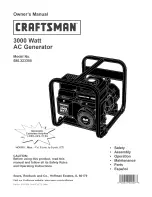
OPERATIONAL CHECK
This section describes a sequence to confirm the basic operation of the instrument. It
should be performed after receiving the instrument. It is a useful learning exercise as
well.
Before proceeding with this procedure, finish reading this instruction manual
thoroughly. Then read the “Local Control” section of the “Programming Manual for -B
Instruments” thoroughly. The “Local Control” section describes the front panel controls
used in this operational check - in particular, the MOVE, CHANGE, and ADJUST
controls.
A 50 Ohm load is
required
for proper operation. The output stage may be damaged if
the output is not terminated into a 50Ω load.
The AVR-E3A-B output may be observed using either a high-speed sampling
oscilloscope, or a slower real-time oscilloscope. To accurately observe these rising and
falling edges, a sampling oscilloscope with a bandwidth of 2 GHz is required. However,
if the rising and falling edges do not need to be accurately observed, it may be more
convenient to use a real-time oscilloscope. The two basic test arrangements are
outlined in the figures below:
BASIC TEST ARRANGEMENT, WITH A SAMPLING OSCILLOSCOPE
24
AVTECH
PULSER
MAIN OUTPUT
CONNECTOR
SYNC
CONNECTOR
AC
POWER
ALL CABLES: 50 OHM COAXIAL
SAMPLING
OSCILLOSCOPE
BW > 2 GHz
50 OHM INPUT
TRIG
CONNECTOR
60 dB
ATTENUATOR
Summary of Contents for AVR-E3A-B
Page 33: ...WIRING DIAGRAMS WIRING OF AC POWER...
Page 34: ...PCB 158R5 LOW VOLTAGE POWER SUPPLY...
Page 35: ...PCB 235C HIGH VOLTAGE DC POWER SUPPLY...
Page 36: ...PCB 231A DC OFFSET SOURCE...
Page 37: ...PCB 217B RELAY DRIVER...
Page 38: ...PCB 104G KEYPAD DISPLAY BOARD...
Page 40: ...PERFORMANCE CHECKSHEET 40...
















































